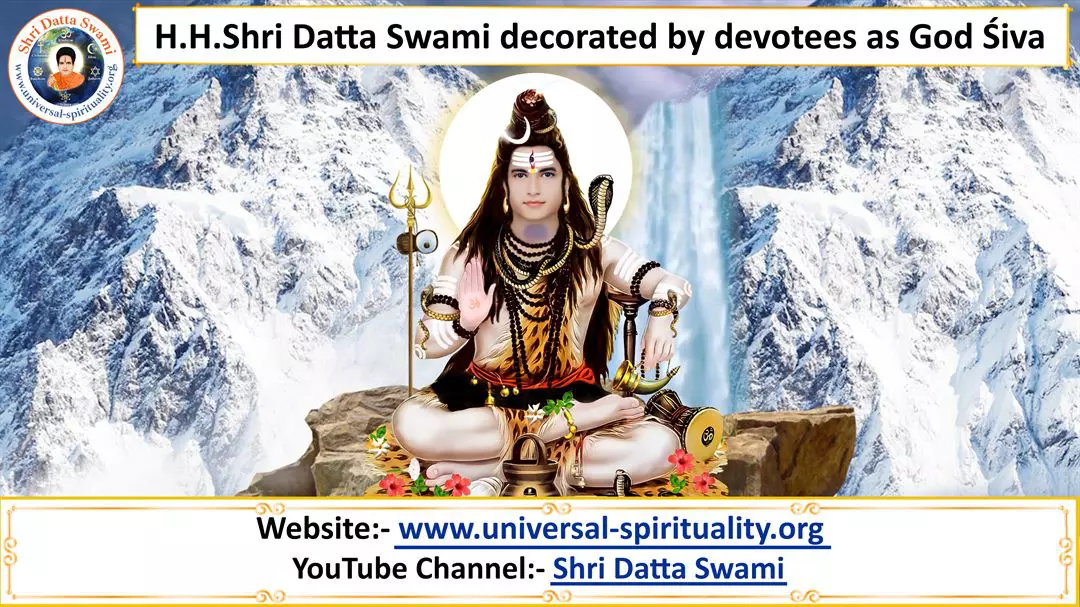
11 Jun 2025
Part-2
11. Is the Nivrutti based on Pravrutti, a real Nivrutti?
[Smt. Chhanda Chandra asked: Swami You always say that Pravrutti is the basis for Nivrutti, which is very clearly understood. In the last Satsanga, the reverse of this was also established very nicely that Nivrutti is the basis for Pravrutti. But Swami, is this Nivrutti basis for Pravrutti a real Nivrutti? In my view, it is not.]
Swami replied:- Nivrutti based Pravrutti means that even in worldly life, a devotee is based on the grace of God only for all his/her worldly problems also. An atheist is not based on Nivrutti for worldly problems and for him, the path of Nivrutti is totally absent. But, for a devotee in worldly life, dependence on God is inevitable as we are observing everywhere. When I say that Nivrutti is the basis of Pravrutti, it refers to a devotee accepting the existence of God and this acceptance is absence in atheist. Hence, Nivrutti based Pravrutti means that the devotee is accepting the existence of God unlike an atheist. The basic foundation for both Pravrutti and Nivrutti is the acceptance of existence of God. From this point onwards, Pravrutti and Nivrutti differ from each other in the sense that Pravrutti is the devotion to God aspiring some fruit in return, whereas Nivrutti is the devotion to God without aspiring for any fruit in return. The foundation is like the trunk of a tree and Pravrutti and Nivrutti are like the two branches expanding in opposite directions. Pravrutti based Nivrutti means that the devotee shall maintain himself/herself based on his own hard work (through a job or some property) and shall not depend on other devotees. The reason is that when the devotee propagates spiritual knowledge in the world, society will listen to that spiritual knowledge with utmost care if the devotee is having his own food. If the propagating devotee depends on the food of the listening devotee, the listening devotee will not care for the preached spiritual knowledge because the propagating devotee is always misunderstood as a preacher, who is preaching for the sake of earning food only. In this way, both Pravrutti and Nivrutti are interdependent on each other.
12. What are all the ten samskaras?
[Swami, Shri Ramakrishna Paramahamsa told His disciple Rakhal (Swami Brahmananda) that getting married is one of the ten samskaras. What all are these ten samskaras, Swami?]
Swami replied:- From birth to death, there are sixteen rituals called samskaaras. Some take ten only as very important samskaaras. Samskaara means the fascination towards some worldly items or activities. Of course, in every samskaara, God is worshiped not based on aspirationless love to God, but, based on attaining the grace of God for success in attaining desired results from those corresponding worldly items or activities. All these belong to Pravrutti or worldly life called Samsaara to which only a samskaara is linked. Paramahamsa is stressing on the Pravrutti (Justified worldly life) in which sex is confined between husband and wife only, which is better than Dushpravrutti (unjust worldly life) in which sinful free sex is taking place. Of course, Nivrutti or spiritual life is better than even Pravrutti. Nivrutti is the sky, Pravrutti is this earth and Dushpravrutti is the lowest hell.
13. Where will Shri Paramahamsa come in different types of incarnations?
[Master Samadrito asked: Following are the questions by my son Master Samadrito. I am putting his questions as he has written: Swami, You explained to us different types of incarnations of Lord Datta like energetic, human, direct, primary, secondary etc. In those categories, where will Shri Ramakrishna Paramahamsa come though I understand that He is the incarnation of Lord Datta only?]
Swami replied:- Ramakrishna Paramahamsa is the direct human incarnation of God Datta, who came down to give best clarifications for some confusions in spiritual line.

14. Why are two worlds described for Lord Shiva namely Kailash in martya loka and Shiva loka in upper world?
[Swami, why two lokas are described for Lord Shiva namely Kailash loka (martya loka) and Shiva loka (upper world) but for other forms of Lord Datta we talk only about single upper loka? At Your divine lotus feet always, Samadrito and Chhanda.]
Swami replied:- For every energetic incarnation, you have the upper energetic world as its abode. For every energetic or past human incarnation, you have many abodes on the earth called as temples containing the statue of that incarnation, which is the representative model of the corresponding incarnation. You can have direct worship (Sakshaat Upaasana) of God in the worship of contemporary incarnation only. For the indirect worship (Pratiika Upaasana), all energetic incarnations and past human incarnations existing in the upper worlds can be worshipped on the earth through their statues. You have the facility of direct worship on the earth in the case of contemporary human incarnation only. In the temples on the earth, you have the facility for indirect worship for all energetic incarnations and past human incarnations.
★ ★ ★ ★ ★
Also Read
Swami Answers Questions Of Smt. Chhandaa Chandra
Posted on: 27/05/2025Replies Of Swami To Smt. Chhanda Chandra's Questions
Posted on: 26/02/2025Divine Experiences Of Smt. Chhanda Chandra
Posted on: 12/06/2022Swami Answers Questions Of Smt. Chhanda
Posted on: 01/10/2023Swami Answers Questions Of Smt. Chhanda
Posted on: 07/06/2024
Related Articles
What Knowledge Is To Be Preached To Children I.e., About Pravritti Alone Or Nivritti Also?
Posted on: 22/08/2021Job Of Spiritual Knowledge Propagator Starts With Introduction Of Existence Of God To Punish Sin
Posted on: 15/10/2016Is Pravrutti The Basis Of Nivrutti Or Vice Versa?
Posted on: 26/03/2023Is The Soul's Free Will Has More Scope In Nivrutti Than In Pravrutti?
Posted on: 09/10/2021